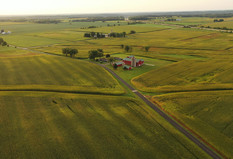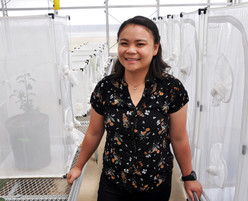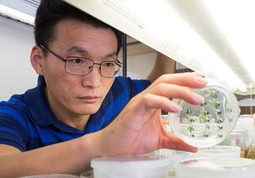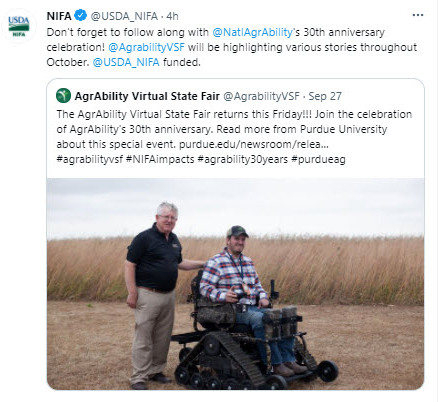| Having trouble viewing this email? View it as a Web page.  | | | Editor: Kelly Sprute September 29, 2021 Making a Difference  Sprouts of micro green broccoli, courtesy of Adobe Stock. Microgreens Go from Trendy Vegetables to Functional Food Starting decades ago as fashionable, high-value gourmet greens, today microgreens have gained popularity among consumers for their nutritional profile and high content of antioxidant compounds. Now, a new study suggests that the tiny plants have the potential to help provide global nutrition security. As part of a project titled, "Food Resilience in the Face of Catastrophic Global Events," an international team of researchers has found these vegetables can be grown in a variety of soilless production systems in small spaces indoors, with or without artificial lighting. The findings are especially relevant amid a pandemic that has disrupted food supply chains. "The current COVID-19 pandemic revealed the vulnerability of our food system and the need to address malnutrition issues and nutrition-security inequality, which could be exacerbated by potential future emergencies or catastrophes," said Penn State University Assistant Professor, team leader Francesco Di Gioia. "Nutrient-dense microgreens have great potential as an efficient food-resilience resource." Open Philanthropy and USDA's National Institute of Food and Agriculture supported this research. For more information, read this Penn State News article. | |  NIFA Invests Over $10M for Food Safety Outreach, Training and Education USDA's National Institute of Food and Agriculture (NIFA) announced today an investment of $10 million for 21 grants to develop and implement food safety and Food Safety Modernization Act-related training, education, Extension outreach and technical assistance for food processors and farmers with small to mid-size operations. "The Centers for Disease Control and Prevention reports 48 million people in this country get sick from foodborne illness each year. Education and outreach are essential for ensuring our food supply is safe from the field to the table," said NIFA Director Dr. Carrie Castille. For more information, read this NIFA press release. Food factory worker wearing mask and protective gear. Photo courtesy of Adobe Stock. |  USDA Announces $3 Billion Investment in Agriculture, Animal Health, and Nutrition; Unveils New Climate Partnership Initiative, Requests Public Input Agriculture Secretary Tom Vilsack today announced a comprehensive set of investments to address challenges facing America's agricultural producers. These include assistance to address challenges and costs associated with drought, animal health, market disruptions for agricultural commodities, and school food supply chain issues. Secretary Vilsack also outlined and requested public comments on a new climate partnership initiative designed to create new revenue streams for producers via market opportunities for commodities produced using climate-smart practices. For more information, read this USDA press release. Aerial view of a Midwestern farm, courtesy of Adobe Stock. |  USDA Announces Intent to Establish an Equity Commission, Solicits Nominations for Membership The USDA recently announced it will establish an Equity Commission and is requesting nominations for membership on the Equity Commission Advisory Committee and Equity Commission Subcommittee on Agriculture. The Notice represents an important step towards implementing President Biden's commitment to create an Equity Commission and the American Rescue Plan Act provision that directs USDA to "address historical discrimination and disparities in the agriculture sector… [through] one or more equity commissions to address racial equity issues within USDA and its programs." "USDA is committed to advancing equity throughout our Department," said Agriculture Secretary Tom Vilsack. "The Equity Commission is an important step in dismantling barriers historically underserved communities have faced in accessing USDA programs and services, especially with regard to access and inclusion in USDA agricultural programs and services." For more information, read this USDA press release. Diversity and Inclusion graphic, courtesy of Adobe Stock. |  UN Food Summit Sets Ambitious Goals for Hunger Reduction and Sustainable Agriculture The United Nations World Food Summit set some ambitious goals for hunger reduction and sustainable production. USDA's Gary Crawford talks with UN Deputy Secretary-General Amina J. Mohammed and Agriculture Secretary Tom Vilsack about climate-smart farming and sustainable agriculture prospects. For more information, listen to this USDA broadcast. Sustainable farming graphic, courtesy of Adobe Stock. |  Key Messages on the International Day of Awareness of Food Loss and Waste Around the world, roughly one-third of food produced for human consumption is lost or wasted from farm to table, amounting to around 1.3 billion tons per year. Covid-19 has exposed vulnerabilities in our food systems and heightened the need to remedy food loss and waste both locally and globally. For more information, read this USDA blog. International Day of Awareness of Food Loss and Waste graphic, courtesy of the USDA. |  NIFA Career Opportunities We are hiring! The National Institute of Food and Agriculture (NIFA) recruits a diverse group of talented, creative, motivated professionals who are invested in shaping the future of food and agricultural science. We offer a variety of benefits and services to our employees that focus on work-life balance, career enhancement, and health and well-being. NIFA has career opportunities in a variety of scientific disciplines covering engineering, food science, forestry, education, animal and crop sciences, and many other agriculture-related disciplines. NIFA job openings are listed on USAJobs. Current NIFA job openings are for Kansas City, Missouri, or location negotiable after selection. Diversity Program Manager (GS-14)
Closing Date: October 8, or when we have received 75 applications
View the merit promotion job announcement (mainly for government employees) |  Nutritional Sciences Researcher Developing Novel Water Filtration Device High-profile food recalls due to outbreaks of diseases like Salmonella shed light on a persistent problem for agriculture: contaminated irrigation water. The water farmers use for crop irrigation is often recycled wastewater. This environmentally friendly practice reduces water demand and recycles nutrients, which promotes soil health and prevents pollutants from entering our waterways. However, this practice carries a significant health risk. Not all water is equally clean, and existing disinfection practices don't catch all waterborne pathogens. University of Connecticut associate professor Yangchao Luo received a $200,000 grant from USDA's National Institute of Food and Agriculture to create biopolymer beads to clean wastewater so it can safely be used for agricultural irrigation. For more information, read this UConn Today article. Center pivot irrigation system, courtesy of Adobe Stock. |  Controlling Pests with Good Vibrations Washington State University (WSU) doctoral Student Dowen Jocson is using vibrations to disrupt pests known as pear psylla as they attempt to mate. The insects, which damage pear trees by sucking their sap and destroying their leaves, communicate via "songs" to attract mates and reproduce. "It opens up a whole new area of study for all of these crop pests," she said. Jocson uses an accelerometer to record the mating calls of the insect pests and playback devices to send vibrations down the stems of the plants. She plays the male pear psylla songs as a deterrent, overwhelming female senses and forcing males to compete with one another. She also plays back a range of white noise frequencies, canceling out some mating songs. Jocson also plans to use sticky traps in pear orchards, using the female vibrational song to lure males. If she is successful, her findings in pears could be used on other pests that attack other crops. Jocson recently received a USDA National Institute of Food and Agriculture grant for $180,000 to support this project. For more information read this WSU blog. Washington State University doctoral Student Dowen Jocson looking for more sustainable and targeted ways to manage insect pests, courtesy of WSU. |  Citrus Microbiome Could Yield Big Plant Health Potential The next key to winning the battle against citrus diseases such as citrus canker may be in the tiniest microbes that live inside the citrus tree. Such is the case for two University of Florida (UF) scientists and their mission to find out how microbes that live deep inside citrus trees might benefit in their natural fight against diseases. University of Florida colleagues Nian Wang and Chris Oswalt will identify the beneficial traits of microbes within plants that have the potential to specifically impact citrus pathogens. The project is funded through a $749,990 grant from USDA's National Institute of Food and Agriculture. "A better understanding of the citrus microbiome and innovative approaches in application are required to engineer the plant microbiome for successful disease control," Wang says. "This grant will help us gather important information that moves us closer to that goal." For more information, read this UF article. Nian Wang, University of Florida Professor, courtesy of UF/IFAS. | NIFA Invests $5M in Community Foods Projects Awards NIFA recently awarded 17 Community Foods Projects (CFP) competitive grants for projects to meet the food needs of low-income individuals through food distribution; community outreach to assist in participation in Federally assisted nutrition programs; and projects that improve access to food as part of a comprehensive service. The CFP program aims at increasing self-reliance of communities in providing for the food needs of the communities; and promoting comprehensive responses to local food access, farm, and nutrition issues. Funded CFP projects are designed to meet specific state, tribal, local or neighborhood food and agricultural needs including equipment necessary for the efficient operation of a project; planning for long-term solutions; or creating innovative marketing activities that mutually benefit agricultural producers and low-income consumers.  | | | NIFA's mission is to invest in and advance agricultural research, education, and extension that solve societal challenges. NIFA's investments in transformative science directly support the long-term prosperity and global preeminence of U.S. agriculture. Keep informed about NIFA, USDA, our land-grant and non-land-grant university partners, and stakeholders with the NIFA Update. Read past issues online, sign up for email updates or follow us on Twitter @USDA_NIFA, #NIFAImpacts or LinkedIn @usda-nifa. If you wish to submit a news item or information, send an email to NIFAUpdate. USDA is an equal opportunity lender, provider, and employer. | | | |

No comments:
Post a Comment